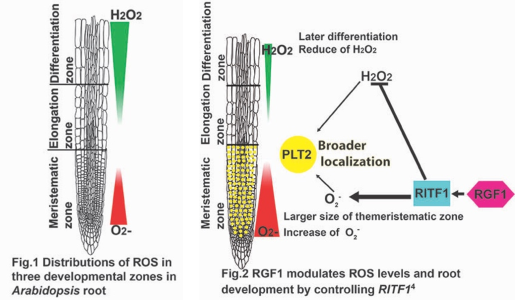Understanding of the regulation mechanism of ROS distributions at the specific root developmental zone under the RGF1 peptide signal
The root is an essential plant organ that supports plants in the soil and obtains water and nutrients. The root apical meristem continually produces all cell types and controls root development throughout a plant's entire life. Therefore, how the root meristem controls root development and adapts to environmental conditions is important for understanding plant development.
Arabidopsis root developmental stages are simply divided into three developmental zones. The cells actively proliferate in the meristematic zone (Fig. 1) and then terminate cell division and initiate cell elongation in the elongation zone (Fig. 1). Finally, the cells become completely mature in the differentiation zone (Fig. 1). Recent findings have demonstrated that reactive oxygen species (ROS) function as signaling molecules to regulate plant development. In the Arabidopsis root, O2- and H2O2 are individually accumulated in the meristematic zone and the elongation and differentiation zones (Fig. 1, red and green) 1,2. The sizes of the three developmental zones are regulated by the distributions of these two types of ROS 1,2.
Stem cell niche and root meristem size are maintained by intercellular interactions and signaling networks of a peptide hormone, Root Meristem Growth Factor 1 (RGF1) 3,4. How RGF1 regulates root meristem development is an essential question for understanding stem cell function. RGF1 controls root development by modulating ROS distributions along Arabidopsis root developmental zones (Fig. 2). RGF1 induced the expression of the primary transcription factor (RITF1) expression within a short-time after RGF1 treatment in the meristematic zone (Fig. 2, blue). Then later, ROS distributions started to be altered at the boundary between the meristematic zone and the elongation zone, finally in the differentiation zone (Fig. 2, red and green). However, the underlying mechanism of how the RGF1 peptide controls ROS distribution along root developmental zones is still unclear.

RGF1 spatiotemporally controls ROS distribution along the root developmental zones by transcriptional and metabolic regulation. We hypothesize that ROS distributions are dynamically controlled by transcriptional and metabolic regulations in the three developmental zones through the RGF1-receptor pathway. To understand the dynamic change of gene expression by RGF1, we perform a multi-omics analysis of the specific developmental zone after RGF1 treatment.
- Dunand, C., Crevecoeur, M. & Penel, C. Distribution of superoxide and hydrogen peroxide in Arabidopsis root and their influence on root development: possible interaction with peroxidases. New Phytol 174, 332-341 (2007). https://doi.org/10.1111/j.1469-8137.2007.01995.x
- Tsukagoshi, H., Busch, W. & Benfey, P. N. Transcriptional regulation of ROS controls transition from proliferation to differentiation in the root. Cell 143, 606-616 (2010). https://doi.org/10.1016/j.cell.2010.10.020
- Matsuzaki, Y., Ogawa-Ohnishi, M., Mori, A. & Matsubayashi, Y. Secreted peptide signals required for maintenance of root stem cell niche in Arabidopsis. Science 329, 1065-1067 (2010). https://doi.org/10.1126/science.1191132
- Yamada, M., Han, X. & Benfey, P. N. RGF1 controls root meristem size through ROS signalling. Nature 577, 85-88 (2020). https://doi.org/10.1038/s41586-019-1819-6